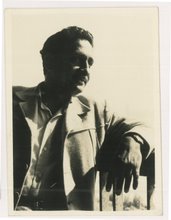
PART 2
A.G: How did the famous Waqt Ne Kiya song from Kagaz Ke Phool with the light beam come about?
V.K: It happened just like that, one day around 4 or 5 p.m. we were sitting in the studio and from top where the ventilators were, we saw light beaming in. It used to happen every day but none of us had looked carefully. So one day myself and Guru Dutt were sitting idle in the studio and I saw this beam and I told Guru Dutt, “ dekhona yeh kitna acha lagta hai”( see how beautiful this looks), utna hi bola mai and suddenly Guru Dutta ne mujhe pakad liya, he said arre Murthy tum aisa karo na hamare picture mei. So I said mei kaisa kar sakta hoon, it is natural sunlight coming through that hole. Guru Dutt said,I don’t know how but I also like it and you are also appreciating, tum kuch karo. Yeh hamara das din ka schedule hai to tum kuch bhi karke karo, bring that effect. So he inspired me. I started thinking how I should do it. I thought maybe I will bring a huge light and put it through a hole. So I got a 10 kilo watt light from Shantaram’s Raj Kamal Studios. But I could not get that effect because that light gives a divergent beam and I wanted a parallel beam…kya karenge? I needed a parallel beam. Next day during lunch time we were sitting, me and Guru Dutt on a cement bench. Just then our make- up man was carrying a mirror in his hand, passing by. Are you getting what I am saying?
A.G: Ah! the make-up man, yes.
V.K: So the sunlight that fell on the mirror threw a ray like thing on the studio wall, so that gave me the idea, (claps his hands and says) I got it, mei bola. Bolo kya chahiye bolo, Guru Dutt asked me. I said, nothing I need two large mirrors. Dutt told the production manager, bring him the two biggest mirrors. We got two mirrors of 4 feet height and 2 and a half feet wide. One mirror I kept in the balcony, outside in the sun light. I kept the balcony door open. The light reflected from that mirror reflected on another mirror inside the studio that was placed on the catwalk.
A.G: So from outside to a mirror inside?
V.K: You see light is a straight beam no? Light travels straight doesn’t it? So we opened studio ventilator doors, kept a mirror there that captured the sunlight which was then reflected onto the mirror on the catwalk. The mirror on the catwalk was tied in a certain way to capture the reflection and then adjusted to suit my frame. Understood? Did you understand?
A.G: You basically channeled the sunlight from outside onto the mirror on the catwalk which was directed onto your frame, which we see in the sequence?
V.K: Yes, correct. We positioned the light as we needed and then we put some lubhan (it is like a large incense stick that produces smoke).
A.G: What did you put?
V.K: Lubhan, lubhan, woh lubhan dalne se smoke aata hai (Lubhan produces smoke) because if there is no smoke you cannot see the light beam clearly and lubhan smoke is good for health also. Thats how I got that shot, that became a historical shot in Indian cinematography in those days.
A.G: It still is!
V.K: There were many directors and cameramen, there was this cameraman for Mehboob Studio called Fareedoon Irani, he had seen me doing this and he asked me, “Murthy kya kar rahe ho?” (what are you doing?) So I said, “aise hi koi experiment kar raho hoon”. (I am just experimenting). He said “acha”, didn’t say anything more, he was a senior most cameraman. Next day, I wanted this shot to be immediately developed and processed since I wanted to see the results, how it looked. The rushes had come but I was shooting so it was sent to the projection room. You know what, in the meanwhile this Fareedoon Irani went and saw it! (Laughs)
A.G: Before you?
V.K: In the lunchtime I was so going towards the projection room, dekhne ke liye. Just then Fareedoon sahib was coming down the staircase and he said , “ arre Murthy, kya kamal kaam kiya re” ( Murthy you have done such fantastic work) and he came and embraced me and said that for so many years we were not able to do it but you have done a great thing. He said, “go go and see your own work, it is so beautiful”. That was the biggest compliment I got and also I was very happy. But I never thought it would become history. I thought the beam looks good in the studio. At that time it didn’t occur to me that it was such a great thing. Accidentally we did it and said chalo maja atta hai, issi liye kar diya. (We were having fun and we just did it!)

